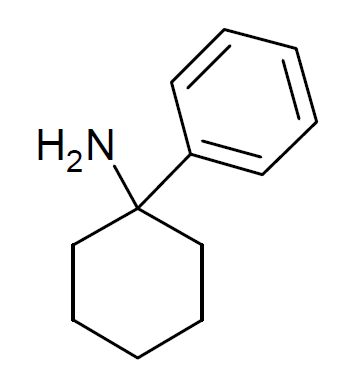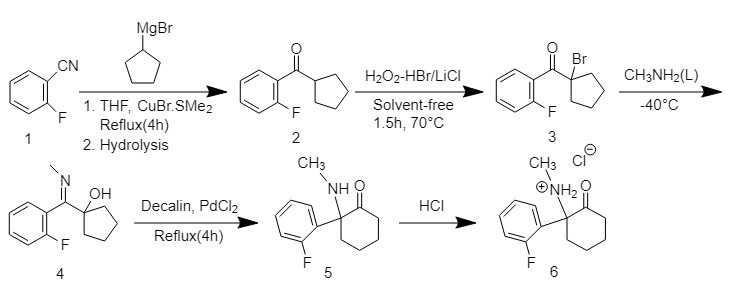|
Bromoketamine
2-Bromodeschloroketamine (also known as 2-Br-2'-Oxo-PCM and Bromoketamine) is a chemical compound of the arylcyclohexylamine class, which is an analog of the dissociative anesthetic drug ketamine in which the chlorine atom has been replaced with a bromine atom. It is used in scientific research as a comparison or control compound in studies into the metabolism of ketamine and norketamine, and has also been sold online alongside arylcyclohexylamine designer drugs, though it is unclear whether bromoketamine has similar pharmacological activity. See also * 2-Fluorodeschloroketamine * 3-Fluorodeschloroketamine * Deschloroketamine * Methoxyketamine * Trifluoromethyldeschloroketamine Trifluoromethyldeschloroketamine (TFMDCK) is a designer drug from the arylcyclohexylamine family, which is presumed to have similar properties to ketamine, a dissociative anesthetic drug with hallucinogenic and sedative effects. It has been sold o ... References Arylcyclohexylamines Designer dru ... [...More Info...] [...Related Items...] OR: [Wikipedia] [Google] [Baidu] |
Arylcyclohexylamines
Arylcyclohexylamines, also known as arylcyclohexamines or arylcyclohexanamines, are a chemical class of pharmaceutical, designer, and experimental drugs. History Phencyclidine (PCP) is believed to be the first arylcyclohexylamine with recognized anesthetic properties, but several arylcyclohexylamines were described before PCP in the scientific literature, beginning with PCA (1-phenylcyclohexan-1-amine) the synthesis of which was first published in 1907. PCE was reported in 1953 and PCMo (4-(1-phenyl-cyclohexyl)-morpholine see chart below for figure) in 1954, with PCMo described as a potent sedative. Arylcyclohexylamine anesthetics were intensively investigated at Parke-Davis, beginning with the 1956 synthesis of phencyclidine and later the related compound ketamine. The 1970s saw the debut of these compounds, especially PCP and its analogues, as illicitly used recreational drugs due to their dissociative hallucinogenic and euphoriant effects. Since that time, the class has be ... [...More Info...] [...Related Items...] OR: [Wikipedia] [Google] [Baidu] |
Arylcyclohexylamine
Arylcyclohexylamines, also known as arylcyclohexamines or arylcyclohexanamines, are a chemical class of pharmaceutical, designer, and experimental drugs. History Phencyclidine (PCP) is believed to be the first arylcyclohexylamine with recognized anesthetic properties, but several arylcyclohexylamines were described before PCP in the scientific literature, beginning with PCA (1-phenylcyclohexan-1-amine) the synthesis of which was first published in 1907. PCE was reported in 1953 and PCMo (4-(1-phenyl-cyclohexyl)-morpholine see chart below for figure) in 1954, with PCMo described as a potent sedative. Arylcyclohexylamine anesthetics were intensively investigated at Parke-Davis, beginning with the 1956 synthesis of phencyclidine and later the related compound ketamine. The 1970s saw the debut of these compounds, especially PCP and its analogues, as illicitly used recreational drugs due to their dissociative hallucinogenic and euphoriant effects. Since that time, the class has be ... [...More Info...] [...Related Items...] OR: [Wikipedia] [Google] [Baidu] |
2-Fluorodeschloroketamine
2-Fluorodeschloroketamine (also known as 2'-Fl-2-Oxo-PCM, Fluoroketamine and 2-FDCK) is a dissociative anesthetic related to ketamine. Its sale and use as a designer drug has been reported in various countries. It is an analogue of ketamine where the chlorine group has been replaced by fluorine. Due to its recent emergence, the pharmacological specifics of the compound are mostly unclear. Effects are still ketamine like but with more euphoria and analgesic properties. History The synthesis of 2-FDCK was first described in a 2013 paper as part of a larger effort to synthesize and evaluate new anesthetic drugs based on ketamine and its analogues. Ketamine itself was first introduced in 1964 and was approved for clinical use in 1970. Since then it has become one of the most important and applicable general anesthetics as well as a popular recreational drug. The use of 2-FDCK as a research chemical has been reported in various countries.European Monitoring Centre for Drugs and Dr ... [...More Info...] [...Related Items...] OR: [Wikipedia] [Google] [Baidu] |
Deschloroketamine
Deschloroketamine (DXE, DCK, 2'-Oxo-PCM) is a dissociative anesthetic that has been sold online as a designer drug. It has also been proposed for the treatment of bacterial, fungal, viral or protozoal infections and for immunomodulation at doses of 2 mg per day. History In 2019, it became part of a group of molecules studied by the French laboratory Caulredaitens. Legal status Deschloroketamine is illegal in Latvia, and is covered by blanket bans in Canada and the UK. See also * Ketamine * 2-Fluorodeschloroketamine * 3-Fluorodeschloroketamine * Bromoketamine * Methoxmetamine * Trifluoromethyldeschloroketamine * Rhynchophylline Rhynchophylline is an alkaloid found in certain ''Uncaria'' species (Rubiaceae), notably '' Uncaria rhynchophylla'' and '' Uncaria tomentosa''. It also occurs in the leaves of ''Mitragyna speciosa'' (kratom), a tree native to Thailand. Chemicall ... References Arylcyclohexylamines Designer drugs Dissociative drugs Ketones NMD ... [...More Info...] [...Related Items...] OR: [Wikipedia] [Google] [Baidu] |
Methoxyketamine
Methoxyketamine or 2-MeO-2-deschloroketamine is a designer drug of the arylcyclohexylamine class first reported in 1963. It is an analog of ketamine in which the chlorine atom has been replaced with a methoxy group. Its synthesis by rearrangement of an amino ketone has been reported. As an arylcyclohexylamine, methoxyketamine most likely functions as an NMDA receptor antagonist. It produces sedative, hallucinogenic, and (at high doses) anesthetic effects, but with a lower potency than ketamine itself. See also * 2-Fluorodeschloroketamine * Bromoketamine * Methoxmetamine * Trifluoromethyldeschloroketamine Trifluoromethyldeschloroketamine (TFMDCK) is a designer drug from the arylcyclohexylamine family, which is presumed to have similar properties to ketamine, a dissociative anesthetic drug with hallucinogenic and sedative effects. It has been sold ... References Arylcyclohexylamines Designer drugs Dissociative drugs Ketones Phenol ethers {{organic-compound-stu ... [...More Info...] [...Related Items...] OR: [Wikipedia] [Google] [Baidu] |
Trifluoromethyldeschloroketamine
Trifluoromethyldeschloroketamine (TFMDCK) is a designer drug from the arylcyclohexylamine family, which is presumed to have similar properties to ketamine, a dissociative anesthetic drug with hallucinogenic and sedative effects. It has been sold over the internet since around 2016, though genuine samples appear to be rare. The ''o''-trifluoromethyl analogue of hydroxynorketamine has also been researched as an antidepressant. See also * Bromoketamine * Deschloroketamine * Methoxyketamine * Methoxmetamine Methoxmetamine (also known as 3-MeO-2'-Oxo-PCM, MXM and MMXE) is a dissociative anesthetic of the arylcyclohexylamine class that is closely related to methoxetamine and methoxyketamine, and has been sold online as a designer drug A designer drug ... References Arylcyclohexylamines Designer drugs Dissociative drugs Trifluoromethyl compounds {{nervous-system-drug-stub ... [...More Info...] [...Related Items...] OR: [Wikipedia] [Google] [Baidu] |
Analog (chemistry)
A structural analog (analogue in modern traditional English; Commonwealth English), also known as a chemical analog or simply an analog, is a compound having a structure similar to that of another compound, but differing from it in respect to a certain component. It can differ in one or more atoms, functional groups, or substructures, which are replaced with other atoms, groups, or substructures. A structural analog can be imagined to be formed, at least theoretically, from the other compound. Structural analogs are often isoelectronic. Despite a high chemical similarity, structural analogs are not necessarily functional analogs and can have very different physical, chemical, biochemical, or pharmacological properties. In drug discovery, either a large series of structural analogs of an initial lead compound are created and tested as part of a structure–activity relationship study or a database is screened for structural analogs of a lead compound. Chemical analogues of il ... [...More Info...] [...Related Items...] OR: [Wikipedia] [Google] [Baidu] |
Dissociative
Dissociatives, colloquially dissos, are a subclass of hallucinogens which distort perception of sight and sound and produce feelings of detachment – dissociation – from the environment and/or self. Although many kinds of drugs are capable of such action, dissociatives are unique in that they do so in such a way that they produce hallucinogenic effects, which may include dissociation, a general decrease in sensory experience, hallucinations, dream-like states or anesthesia. Some of these substances, which are nonselective in action and affect the dopamine and/or opioid systems, may be capable of inducing euphoria or symptoms which are more akin to the effects of certain “hard drugs” or common drugs of abuse. This is likely why dissociatives are considered to be addictive with a fair to moderate potential for abuse, unlike psychedelics. Despite some dissociatives, such as phencyclidine (PCP) possessing stimulating properties, most dissociatives seem to have a general depre ... [...More Info...] [...Related Items...] OR: [Wikipedia] [Google] [Baidu] |
Anesthetic
An anesthetic (American English) or anaesthetic (British English; see spelling differences) is a drug used to induce anesthesia — in other words, to result in a temporary loss of sensation or awareness. They may be divided into two broad classes: general anesthetics, which result in a reversible loss of consciousness, and local anesthetics, which cause a reversible loss of sensation for a limited region of the body without necessarily affecting consciousness. A wide variety of drugs are used in modern anesthetic practice. Many are rarely used outside anesthesiology, but others are used commonly in various fields of healthcare. Combinations of anesthetics are sometimes used for their synergistic and additive therapeutic effects. Adverse effects, however, may also be increased. Anesthetics are distinct from analgesics, which block only sensation of painful stimuli. Local anesthetics Local anesthetic agents prevent the transmission of nerve impulses without causi ... [...More Info...] [...Related Items...] OR: [Wikipedia] [Google] [Baidu] |
Ketamine
Ketamine is a dissociative anesthetic used medically for induction and maintenance of anesthesia. It is also used as a recreational drug. It is one of the safest anesthetics, as, in contrast with opiates, ether, and propofol, it suppresses neither respiration nor heart rate. Ketamine is also simple to administer and highly tolerable compared to drugs with similar effects which are flammable, irritating, or even explosive. Ketamine is a novel compound, derived from PCP, created in pursuit of a safer anesthetic with similar characteristics. Ketamine is also used for acute pain management. At anesthetic doses, ketamine induces a state of "dissociative anesthesia", a trance-like state providing pain relief, sedation, and amnesia. The distinguishing features of ketamine anesthesia are preserved breathing and airway reflexes, stimulated heart function with increased blood pressure, and moderate bronchodilation. At lower, sub-anesthetic doses, ketamine is a promising agent for pain ... [...More Info...] [...Related Items...] OR: [Wikipedia] [Google] [Baidu] |
Norketamine
Norketamine, or ''N''-desmethylketamine, is the major active metabolite of ketamine, which is formed mainly by CYP3A4. Similarly to ketamine, norketamine acts as a noncompetitive NMDA receptor antagonist (Ki = 1.7 μM and 13 μM for (''S'')-(+)-norketamine and (''R'')-(–)-norketamine, respectively), but is about 3–5 times less potent as an anesthetic in comparison. Also, similarly again to ketamine, norketamine binds to the μ- and κ-opioid receptors. Relative to ketamine, norketamine is much more potent as an antagonist of the α7-nicotinic acetylcholine receptor, and produces rapid antidepressant effects in animal models which have been reported to correlate with its activity at this receptor. However, norketamine is about 1/5 as potent as ketamine as an antidepressant in mice as per the forced swim test, and this seems also to be in accordance with its 3–5-fold reduced comparative potency ''in vivo Studies that are ''in vivo'' (Latin for "within the living"; o ... [...More Info...] [...Related Items...] OR: [Wikipedia] [Google] [Baidu] |
Designer Drug
A designer drug is a structural or functional analog of a controlled substance that has been designed to mimic the pharmacological effects of the original drug, while avoiding classification as illegal and/or detection in standard drug tests. Designer drugs include psychoactive substances that have been designated by the European Union as new psychoactive substances (NPS) as well as analogs of performance-enhancing drugs such as designer steroids. Some of these were originally synthesized by academic or industrial researchers in an effort to discover more potent derivatives with fewer side effects, and shorter duration (and possibly also because it is easier to apply for patents for new molecules) and were later co-opted for recreational use. Other designer drugs were prepared for the first time in clandestine laboratories. Because the efficacy and safety of these substances have not been thoroughly evaluated in animal and human trials, the use of some of these drugs may result i ... [...More Info...] [...Related Items...] OR: [Wikipedia] [Google] [Baidu] |



.jpg)
